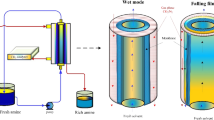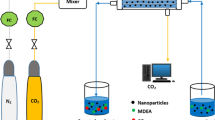Abstract
Removal of carbon dioxide from gas mixtures is of vital importance for the control of greenhouse gas emission. This study presents a numerical simulation using computational fluid dynamics of mass and momentum transfer in hollow-fiber membrane contactors. The simulation was conducted for physical and chemical absorption of CO2. A mass transfer model was developed to study CO2 transport through hollow-fiber membrane contactors. The model considers axial and radial diffusions in the contactor. It also considers convection in the tube and shell side with chemical reaction. The model equations were solved by numerical method based on finite element method. Moreover, the simulation results were validated with the experimental data obtained from literature for absorption of CO2 in amine aqueous solutions as solvent. The simulation results were in good agreement with the experimental data for different values of gas and liquid velocities. The simulation results indicated that the removal of CO2 increased with increasing liquid velocity in the tube side. Simulation results also showed that hollow-fiber membrane contactors have a great potential in the area of gas separation specially CO2 separation from gas mixtures.









Similar content being viewed by others
Abbreviations
- A :
-
Cross-section of shell (m2)
- C 0 :
-
Inlet CO2 concentration (mol/m3)
- C :
-
Concentration (mol/m3)
- \( C_{{\text{CO}}_{2}{\text{-}}{\text{membrane}}}\) :
-
CO2 concentration in the membrane (mol/m3)
- \( C_{{\text{CO}}_{2}{\text{-}}{\text{shell}}}\) :
-
CO2 concentration in the shell (mol/m3)
- \( C_{{\text{CO}}_{2}{\text{-}}{\text{tube}}}\) :
-
CO2 concentration in the tube (mol/m3)
- C i :
-
Concentration of any species (mol/m3)
- C i-shell :
-
Concentration of any species in the shell (m2/s)
- C in :
-
Absorbent concentration at the inlet (mol/m3)
- C inlet :
-
Inlet concentration of CO2 in the shell (mol/m3)
- C outlet :
-
Outlet concentration of CO2 in the shell (mol/m3)
- D :
-
Diffusion coefficient (m2/s)
- \( D_{{\text{CO}}_{2}{\text{-}}{\text{membrane}}}\) :
-
Diffusion coefficient of CO2 in the membrane (m2/s)
- \( D_{{\text{CO}}_{2}{\text{-}}{\text{tube}}}\) :
-
Diffusion coefficient of CO2 in the tube (m2/s)
- D i-shell :
-
Diffusion coefficient of any species in the shell (m2/s)
- J i :
-
Diffusive flux of any species (mol/m2 s)
- \( J_{{{\text{CO}}_{2} }} \) :
-
Mass transfer rate of CO2 (mol/(m2 s))
- k :
-
Reaction rate coefficient of CO2 with absorbent (m3/mol s)
- L :
-
Length of the fiber (m)
- m :
-
Physical solubility (–)
- n :
-
Number of fibers
- P :
-
Pressure (Pa)
- Qshell :
-
Gas flow rate (ml/min)
- Qtube :
-
Liquid flow rate (ml/min)
- r 1 :
-
Tube inner radius (m)
- r 2 :
-
Tube outer radius (m)
- r 3 :
-
Shell inner radius (m)
- r :
-
Radial coordinate (m)
- R :
-
Module inner radius (m)
- R i :
-
Overall reaction rate of any species (mol/m3 s)
- Re :
-
Reynolds number (–)
- t :
-
Time (s)
- T :
-
Temperature (K)
- T l :
-
Liquid temperature (K)
- T g :
-
Gas temperature (K)
- u :
-
Average velocity (m/s)
- U g :
-
Gas velocity (m/s)
- U l :
-
Liquid velocity (m/s)
- V :
-
Velocity in the module (m/s)
- V z-shell :
-
Z velocity in the shell (m/s)
- V z-tube :
-
Z velocity in the tube (m/s)
- x p :
-
Constant used in (29) (–)
- x w :
-
Constant used in (30) (–)
- z :
-
Axial coordinate (m)
- ε:
-
Porosity
- ν:
-
Volumetric flow rate (m3/s)
- τ:
-
Tortuosity
- ϕ:
-
Module volume fraction
- α:
-
Loading of CO2 in amine (kmol of CO2/kmol of amine)
- \( \upeta \) :
-
CO2 removal efficiency
- η:
-
Gas viscosity (Pa.s)
- ρ:
-
Density (kg/m3)
References
Herzog H, Eliasson B, Kaarstad O (2000) Capturing greenhouse gases. Sci Am 182:72–79
Desideri U, Paolucci A (1999) Performance modeling of a carbon dioxide removal system for power plants. Energy Convers Manag 40:1899–1915
Herzog H (2001) What future for carbon capture and sequestration? ES&T 35:148A–153A
Gabelman A, Hwang ST (1999) Hollow fiber membrane contactors. J Membr Sci 159:61–106
Qi Z, Cussler EL (1985) Microporous hollow fibers for gas absorption. J Membr Sci 23:321–345
Kreulen H, Smolders CA, Versteeg GF, Van Swaaij WPM (1993) Microporous hollow fiber membrane modules. Ind Eng Chem Res 32:674–684
Falk-Pederson O, Dannstrom H (1997) Separation of carbon dioxide from offshore gas turbine exhaust. Energy Convers Manag 38:S81–S86
Kreulen H, Smolders CA, Versteeg GF, Van Swaaij WPM (1993) Microporous hollow fiber membrane modules as gas–liquid contactors. 2. Mass transfer with chemical reaction. J Membr Sci 78:217–238
Kumar PS, Hogendoorn JA, Feron PHM, Versteeg GF (2002) New absorption liquids for the removal of CO2 from dilute gas streams using membrane contactors. Chem Eng Sci 57:1639–1651
Karror S, Sirkar KK (1993) Gas absorption studies in microporous hollow fiber membrane modules. Ind Eng Chem Res 32:674–684
Zhang HY, Wang R, Tee Liang D, Hwa Tay J (2006) Modeling and experimental study of CO2 absorption in a hollow fiber membrane contactor. J Membr Sci 279:301–310
Kim YS, Yang SM (2000) Absorption of carbon dioxide through hollow fiber membranes using various aqueous absorbents. Sep Purif Technol 21:101–109
Happel J (1959) Viscous flow relative to arrays of cylinders. AIChE J 5:174–177
Bird RB, Stewart WE, Lightfoot EN (2002) Transport phenomena, 2nd edn. Wiley, New York
Blauwhoff PMM, Versteeg GF, Van Swaaij WPM (1984) A study on the reaction between CO2 and alkanolamines in aqueous solutions. Chem Eng Sci 39:207–225
Danckwerts PV (1979) The reaction of CO2 with ethanolamines. Chem Eng Sci 34:443–446
Barth D, Tondre C, Lappai G, Delpuech J (1981) Kinetic study of carbon dioxide reaction with tertiary amines in aqueous solutions. J Phys Chem 85:3660–3667
Liao CH, Li MH (2002) Kinetics of absorption of carbon dioxide into aqueous solutions of monoethanolamine + N-methyldiethanolamine. Chem Eng Sci 57:4569–4582
Reid RC, Prausnitz JM, Poling BE (1987) The properties of gases and liquids. McGraw-Hill, New York
Wang YW, Xu S, Otto FD, Mather AE (1992) Solubility of N2O in alkanolamines and mixed solvents. J Chem Eng 48:31–40
Hagewiesche PD, Aami SA, Hani Al-Ghawas A, Orville CS (1995) Absorption of carbon dioxide into aqueous blends of monoethanolamine and N-methyldiethanolamine. Chem Eng Sci 50:1071–1079
Versteeg GF, Van Swaaij WPM (1988) Solubility and diffusivity of acid gases (CO2, N2O) in aqueous alkanolamine solutions. J Chem Eng Data 33:29–34
Yan S, Fang M, Zhang W, Wang S, Xu Z, Luo Z, Cen K (2007) Experimental study on the separation of CO2 from flue gas using hollow fiber membrane contactors without wetting. Fuel Process Technol 88:501–511
Gabelman A, Hwang ST, Krantz WB (2005) Dense gas extraction using a hollow fiber membrane contactor: experimental results versus model predictions. J Membr Sci 257:11–36
Author information
Authors and Affiliations
Corresponding author
Rights and permissions
About this article
Cite this article
Shirazian, S., Marjani, A. & Rezakazemi, M. Separation of CO2 by single and mixed aqueous amine solvents in membrane contactors: fluid flow and mass transfer modeling. Engineering with Computers 28, 189–198 (2012). https://doi.org/10.1007/s00366-011-0237-7
Received:
Accepted:
Published:
Issue Date:
DOI: https://doi.org/10.1007/s00366-011-0237-7




